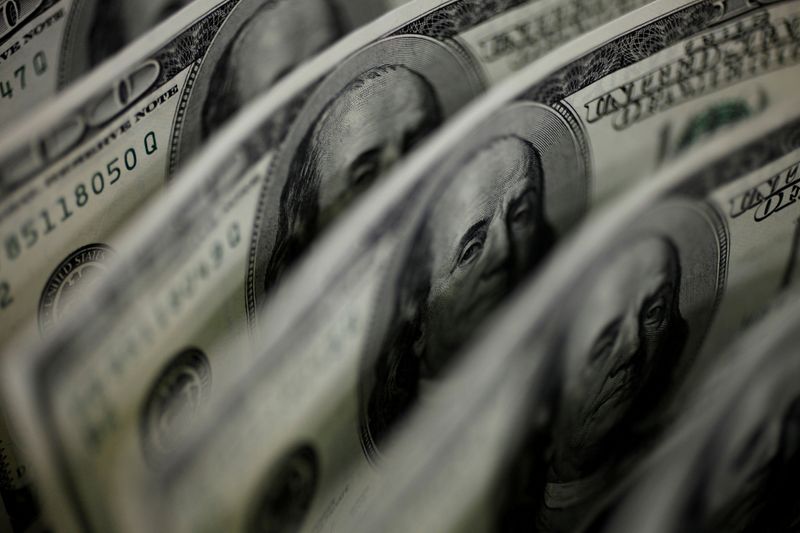By Gertrude Chavez-Dreyfuss and John McCrank
NEW YORK (Reuters) – The dollar ticked higher against major currencies in choppy trading on Tuesday, on track for its first monthly gain since September on views that interest rates will stay elevated for some time as inflation remains stubbornly high, while recession fears kept investors on edge.
Recent upbeat data, such as a blockbuster employment report for January, helped the greenback rally in February on expectations that the Federal Reserve will have to raise interest rates higher and longer than the market had earlier anticipated to fight inflation.
U.S. rate futures have priced in the Federal Reserve’s target policy rate peaking at 5.4% in September, while rate cuts for this year have been largely priced out. The Fed’s policy rate is currently in a 4.50%-4.75% target range.
The dollar index, which measures the currency against a basket of peers, was up 0.22% at 104.88 at 3:20 p.m. ET (2020 GMT), on track for a monthly gain of 2.7%.
Data on Tuesday, meanwhile, showed signs that the Fed’s rate hikes were beginning to have their intended effect of cooling the red-hot economy, which weighed slightly on the dollar.
“Amidst the sea of discouraging news, U.S. consumer confidence data released this morning was ice cold, favorable for fighting inflation, but at a significant implied cost — declining consumer spending which represents approximately 70% of the country’s GDP,” said José Torres, senior economist at Interactive Brokers (NASDAQ:IBKR).
U.S. consumer confidence unexpectedly fell in February, dropping to 102.9 from a 106 reading in January. Economists polled by Reuters had forecast the index would be 108.5.
Another report showed that U.S. single-family home prices increased at their slowest pace in December since the summer of 2020, with the S&P CoreLogic Case Shiller national home price index rising 5.8% year-on-year.
The Chicago PMI business survey for February also came in weaker-than-expected.
The market awaits employment data for February on March 10 and the consumer price index on March 14, both of which could influence the Fed’s interest rate policy.
“The disinflation story continues. It took a bit of a pause in January, but it’s not a reversal. We think some of the dollar strength is exaggerated. So we are cautiously fading dollar strength,” said Vassili Serebriakov, FX strategist, at UBS.
The dollar earlier on Tuesday notched a more-than two-month high against the Japanese yen, climbing to 136.93 yen, before reversing its gains after the U.S. data. The dollar was last down 0.06% against the yen at 136.15.
Japan’s policy of keeping yields pinned down means the yen is sensitive to moves elsewhere. Incoming Bank of Japan (BOJ) Governor Kazuo Ueda said this week it was premature to comment on how the central bank may shift policy.
On Tuesday, incoming Deputy Governor Shinichi Uchida brushed aside the chance of an immediate overhaul of the BOJ’s ultra-loose monetary policy.
The yen also fell to its weakest levels in two months against the euro and the pound.
Elsewhere, the euro slid 0.25% against the dollar to $1.0583. Earlier, it got some support from higher-than-expected French inflation data, which sent short-dated euro zone yields to their highest in at least a decade. [GVD/EUR]
Sterling, meanwhile, gave back some of its gains from the previous session against the dollar, dipping 0.09% to $1.2052.
It surged 1% on Monday after Britain and the European Union announced a new deal for post-Brexit trading arrangements for Northern Ireland, known as the Windsor Framework.
That brightened the outlook for the post-Brexit UK economy, with British Prime Minister Rishi Sunak saying it would clear the way for a new chapter in London’s relationship with the bloc.



